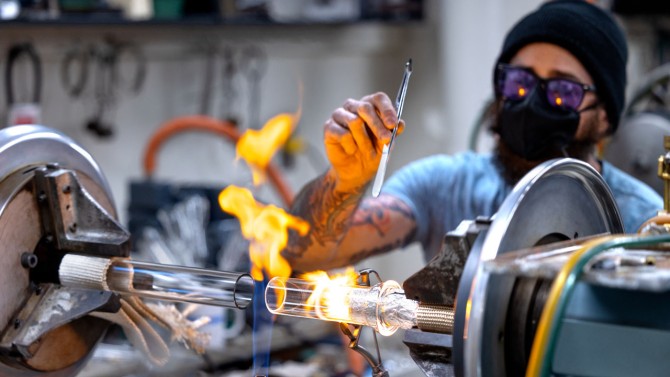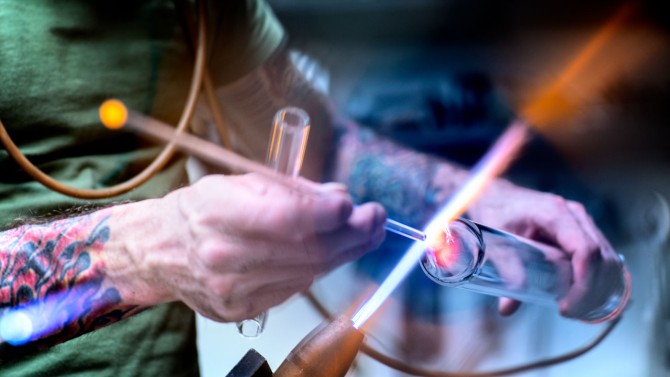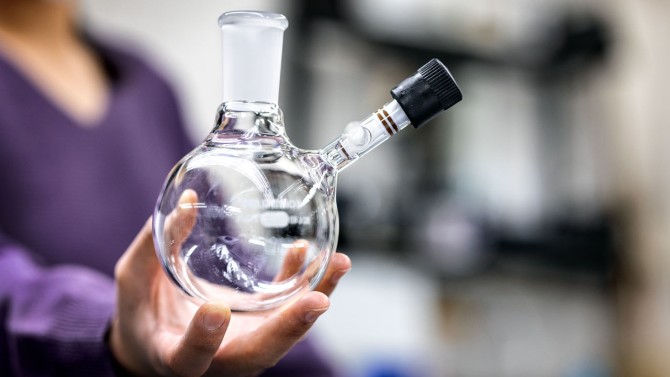Glass blower crafts intricate creations for Cornell scientists
Karl Termini’s worktable holds pieces of glass, metal and rubber, from glass tubes and pipettes to flasks, funnels and columns.
Karl Termini’s worktable holds pieces of glass, metal and rubber, from glass tubes and pipettes to flasks, funnels and columns. Some are intricately crafted together in systems that are headed to research spaces in Baker Lab. Others are works in progress.
Next to it all is a stack of research papers. And somewhere in the office is his advanced organic chemistry textbook; he’s studying independently for the class this semester and has a test coming up.
 Credit:Noël Heaney/Cornell University
Credit:Noël Heaney/Cornell University
Glass blower Karl Termini works with borosilicate glass, quartz or other glass substrates, which are more resistant than traditional soda-lime glass, or “soft glass,” to the shocks and wild temperature swings that can happen in experiments.
“Every day is a chance to learn something,” said Termini, the scientific glass blower for the Department of Chemistry and Chemical Biology in the College of Arts and Sciences (A&S). “Someone will come in with a challenge and they’ll need me to figure out how to do it. I take pride in coming up with a solution. That’s my favorite part.”
Termini manages a host of orders for scientists across campus, many who require custom-made glass equipment. His work saves the departments money and time and ensures that scientists get exactly what they need.
“The success of my project depended on the use of a specialized solid-addition funnel that didn’t exist in the catalogues,” said Kaitlyn MacMillan, a graduate student in the lab of Phillip Milner, assistant professor of chemistry and chemical biology in A&S. “It is cool to think that I am the only person in the world doing this type of work because I am using custom-made glassware handcrafted by Karl.”
Termini also brainstorms ideas for new types of glassware designs with members of Milner’s lab. “He is incredibly dedicated and hardworking, which is reflected in him successfully securing a grant to support his workshop in just his first year here,” Milner said.
On a typical day, 20 to 30 researchers will stop by with projects to be created or fixed; faculty and grad students text him for help with problems they need to solve.
Gabrielle Illava ’17, M.S. ’20, a doctoral student in the lab of Nozomi Ando, associate professor of chemistry and chemical biology in A&S, said Termini is genuinely interested in understanding the intricacies of her research.
“When we were sent defective flasks, he not only fixed them but reached out directly to someone he knew at the company to let them know what the problem was,” she said.
Before he joined Cornell last year, Termini worked for himself as a glassblower for 22 years, doing projects for individuals and industry and training with highly-respected scientific glassblowers. He’s part of the American Scientific Glassblowers Society, a group of about 400 members who consult with each other on some of their more complicated projects.
Scientific glassblowers work with borosilicate glass, quartz or other glass substrates, both of which are more resistant than traditional soda-lime glass, or “soft glass,” to the shocks and wild temperature swings that can happen in experiments.
 Credit:Noël Heaney/Cornell University
Credit:Noël Heaney/Cornell University
Karl Termini works with glass heated to 4,500 degrees Fahrenheit or higher, depending on the type of glass.
“Karl always has time to teach us some of the fascinating chemistry, mechanics and physics – such as expansion coefficients – that he uses day to day in order to invent intricate apparatuses with enough durability to withstand the harsh conditions we chemists regularly subject them to,” said Netgie Laguerre, a graduate student in the lab of Todd Hyster, associate professor of chemistry and chemical biology in A&S.
Upon joining Cornell, Termini quickly refurbished the glass shop at minimal cost, repairing two lathes, computerizing a kiln and bringing in some of his own torches and equipment, said Brian Crane, the George W. and Grace L. Todd Professor of Chemistry and chair of the department. Termini also used his contacts at large glass companies and his experience in the private sector to negotiate more favorable purchasing agreements, Crane said.
Termini’s services and interests do not end with the products he produces, Crane said. “He also installs gas lines, fixes vacuum systems and works with students to design experimental apparatuses to best serve their needs.”
Termini’s shop includes two glassblowing lathes that allow him to rotate and heat a piece of glass while blowing it into shape. He works with glass heated to 4,500 degrees Fahrenheit or higher, depending on the type of glass. He also uses smaller bench burners if rotation isn’t needed. There are goggles, gloves and safety equipment too.
“I’ve always wanted to have the freedom to be my own person and that’s how I feel when I’m working,” Termini said. “There’s a meditative quality to it. My body is in motion and my mind is at ease.”
Termini said he’s never called himself an artist, rather a skilled craftsman who “once in a
 Credit:Noël Heaney/Cornell University
Credit:Noël Heaney/Cornell University
On a typical day, 20 to 30 researchers will stop by the Department of Chemistry’s glass shop with projects to be created or fixed.
while stumbles into art,” he said. “This isn’t about what it looks like, but about what it does.”
Sydney Liu ’23, a biology and society major in A&S, works six hours a week in the shop, producing the tubes most commonly used by researchers. “Glass blowing made up a lot of my high school life,” she said. “I missed it a lot, so when I found out about the glass shop, I reached out to apply.”
While Termini says he prides himself on being creative and productive, he’s also happy that the glass shop has become a popular hang-out for graduate students and faculty alike. He always has donuts on hand and an ear to listen to their concerns, whether they relate to chemistry or to life. “I’m kind of like a hairdresser or a bartender,” he said.
Crane agrees. “Under his direction, the glass shop has become a center of interaction and camaraderie in our department,” he said.
Termini said he appreciates that his work could help solve some of today’s greatest challenges.
“The researchers are building off of each other’s thoughts and inspirations and it’s cool to be a part of that system,” he said. “The ultimate goal is slowing the destruction of the planet, create better medicines or better plastics. To be a little tiny piece of that is very gratifying.”

 Alerts Sign-up
Alerts Sign-up